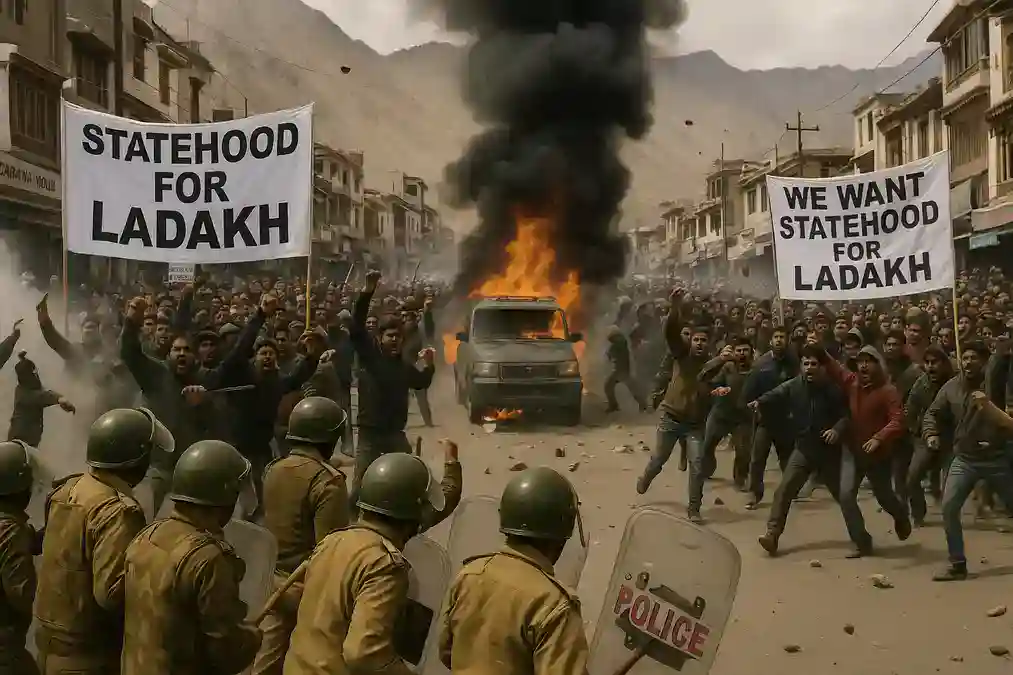Ladakh Statehood Protests Erupt Into Deadly Clash in Leh. A day of protest turned into one of the darkest in recent memory. People came out to demand statehood and constitutional safeguards. By evening, four people were dead. Dozens were lying injured. The streets of Leh saw fire, stone pelting, police action and chaos.
The Beginning of the Day
The protest had been building for weeks. Leaders of the movement had called for a hunger strike. Climate activist Sonam Wangchuk had fasted for more than a month. Two elderly supporters fainted the previous evening. Their collapse shocked the community. Anger was in the air when people gathered on Wednesday morning.
Marchers started peacefully. They shouted slogans. They carried banners. The demand was clear. They wanted Ladakh to become a full state with its own assembly. They wanted Sixth Schedule protection for their land, jobs, and culture.
How the Violence Started
By midday, a group of young men moved ahead of the rally. They marched towards government buildings. Some began throwing stones. A police vehicle was stopped and set on fire. The local office of the BJP was attacked.
Police responded with tear gas and a lathi charge. Crowds scattered. Some regrouped and clashed again. In the confusion, gunfire was reported. Witnesses say police fired live rounds. Officials say it was self-defense.
When the smoke cleared, four people had lost their lives. At least sixty to eighty were injured. Many of them were rushed to the district hospital. Some were police personnel hit by stones and bottles. Others were protesters hit by bullets or batons.
Why People are Angry
Ladakh has been under direct central rule since 2019. When Article 370 was removed, Jammu and Kashmir lost its special status. Ladakh was carved out as a Union Territory. It does not have its own legislature. For many residents, this feels like a denial of voice.
Protesters say they fear outsiders will buy land and take jobs. They say their fragile ecology will suffer without safeguards. They want inclusion under the Sixth Schedule of the Constitution, which protects tribal lands. They also want two separate seats in Parliament, one for Leh and one for Kargil.
The Leaders of the Movement
The protest was not leaderless. It was led by the Leh Apex Body and the Kargil Democratic Alliance. Both groups have campaigned for more rights. Sonam Wangchuk became the face of the hunger strike. His non-violent image drew sympathy across India.
But when violence broke out, he ended his fast. He appealed for calm. He said the fight must remain peaceful. His voice was clear, but the damage was already done.
Ladakh Statehood Protests Erupt Into Deadly Clash in Leh
Four families are in mourning. The names of the dead have not yet been officially released. The injured fill hospital wards. Shops are shut. Tourists are leaving in fear.
A curfew like order has been announced. Gatherings of more than five people are banned in Leh town. Security has been reinforced. The main market is deserted.
The Government’s Stand
Officials called the unrest a planned act. They said outside forces may have pushed the violence. Lt Governor Kavinder Gupta condemned the clashes. He said the right to protest does not mean the right to destroy property.
The central government insisted that talks were already underway. It said it had been engaging with both Leh and Kargil groups. A new round of talks is set for October 6.
Also Read:- Trump Labels India and China as Primary Funders of Russia’s War
The Opposition’s Charge
Opposition parties blamed the centre. They said it was the delay and the neglect that led to anger. Congress leaders accused the BJP of ignoring Ladakh. BJP leaders hit back, accusing Congress of fueling the agitation.
The blame game is in full swing. But for the common people of Ladakh, the loss is real and painful.
Why Violence Broke Out Now
Observers say frustration has been building. Youth unemployment is high. Promises of development have not been met. People feel left out of decisions that affect their land.
The hunger strike created a sense of urgency. When the two elderly strikers collapsed, emotions overflowed. Young men decided to act. Some crossed the line into violence.
The Bigger Picture
Ladakh is not just any region. It borders China. It is ecologically sensitive. Its culture is distinct. People there believe they cannot be treated as just another district of India.
This makes the demand for statehood more than politics. It is about identity, survival, and respect.
What Lies Ahead
Talks are scheduled in the coming days. But trust is low. Many fear more clashes if promises are not honored. Security forces are on high alert. The administration wants to restore calm. But calm without justice may not last.
The protesters say they will not back down. Leaders say the fight will continue. The question is whether the fight will stay peaceful or slip again into violence.
Conclusion
The statehood protest in Leh was supposed to be a show of unity and determination. It became a scene of death and destruction. Four lives were lost. Dozens were hurt. The region is now under heavy watch.
The people of Ladakh have made their voice heard. The government has to decide whether to listen. Dialogue and compromise are the only way forward. If ignored, the anger may grow deeper.
The tragedy of Leh shows that when demands are not addressed, frustration can turn the streets into a battlefield. Ladakh now waits for answers, and for peace.

